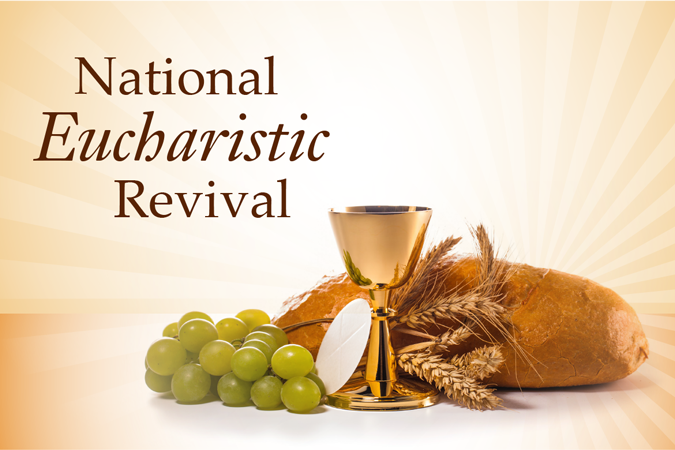
The National Eucharistic Revival is a great opportunity for catechesis on the Eucharist. These articles, videos, and activities aim to help.
For more resources, visit LoyolaPress.com/Eucharist or the USCCB.

The National Eucharistic Revival is a great opportunity for catechesis on the Eucharist. These articles, videos, and activities aim to help.
For more resources, visit LoyolaPress.com/Eucharist or the USCCB.
As catechists, we work with the Holy Spirit to form disciples of Jesus Christ. With that in mind, we’ve been devoting some attention to the concept of discipleship. I can think of no one better to turn to than Fr. Brice Higginbotham, author of Remaining with Jesus: Discipleship in the Gospel of John. Fr. Higginbotham has been recording short videos while pursuing a Licentiate in Sacred Scripture at the Pontifical Biblical Institute in Rome. In this segment, Fr. Brice […]
One night as I was tucking my youngest son into bed, he sat right up as if he had just connected something in his mind and was having an “aha!” moment. “Mom, Mom, is it true?” he said excitedly. “Is what true?” I asked. “You know how at Mass, Father says to us that if we eat this bread, we will live forever?” With an expectant expression on his small face, he held his chubby […]
As the National Eucharistic Revival continues, we reflect on the parts of the Mass and what each part is calling us to do and be the other six days of the week. Our inspiration is my book, Living the Mass: How One Hour a Week Can Change Your Life, co-authored by Fr. Dominic Grassi. Today, we look at the Concluding Rites and reflect on how they help us to begin the work of living out our baptismal commitment […]
Let’s be honest, at one time or another in our lives we may have struggled with getting ourselves or our family to Mass. Whatever the reason, we can always go to Mass with a better attitude. And so what can we do to allow the experience of the Mass to truly be an encounter with Jesus? For more on getting the most out of Mass as a family, read my book, The Catholic Parents’ Survival […]
When it comes to teaching about the Real Presence of Jesus in the Eucharist, one might wonder: why doesn’t the Church grant permission to a group of scientists to examine reverently an unconsecrated host and a consecrated host under a microscope (much as the Church has allowed scientific studies to be conducted on the Shroud of Turin) and report on the differences they see between the two? I can tell you why the Church doesn’t […]
As the National Eucharistic Revival continues, we reflect on the parts of the Mass and what each part is calling us to do and be the other six days of the week. Our inspiration is my book, Living the Mass: How One Hour a Week Can Change Your Life, co-authored by Fr. Dominic Grassi. Today, we look at the Communion Rite and reflect on how it helps us to begin the work of acknowledging that God alone sustains […]
As the National Eucharistic Revival continues, we reflect on the parts of the Mass and what each part is calling us to do and be the other six days of the week. Our inspiration is my book, Living the Mass: How One Hour a Week Can Change Your Life, co-authored by Fr. Dominic Grassi. Today, we look at the Rite of Peace and reflect on how it helps us to begin the work of living […]
In the Sacrament of the Eucharist, we receive the Body and Blood of Jesus Christ. When we celebrate the Eucharist, we join in communion with the family of the Church. Help children deepen their understanding of the Eucharist and the Mass with a fun matching game, People and Things at Mass. The game—with images from God’s Gift: Eucharist—will help children identify the liturgical roles and sacred objects common to all churches. The game can be […]
We continue to journey through the National Eucharistic Revival and reflect on the parts of the Mass and what each part is calling us to do and be the other six days of the week. Our inspiration is my book, Living the Mass: How One Hour a Week Can Change Your Life, co-authored by Fr. Dominic Grassi. This time, we look at the Lord’s Prayer and reflect on how it helps us to begin the work of letting […]
Grab the crayons, and complete a color-by-number activity with children to find that Jesus shared bread and wine with his friends. While designed for use with primary grades, the sheet can also provide a relaxing coloring break for older students. Explain that Jesus is present in the consecrated Bread and Wine at Mass. Extend this activity in the classroom using some of these ideas. Read aloud Luke 22:14–20, the Last Supper. For the story adapted […]
Copyright © 2006-2024 Loyola Press. All rights reserved. Any copying, redistribution, or retransmission of the contents of this service without the express written consent of Loyola Press is expressly prohibited.